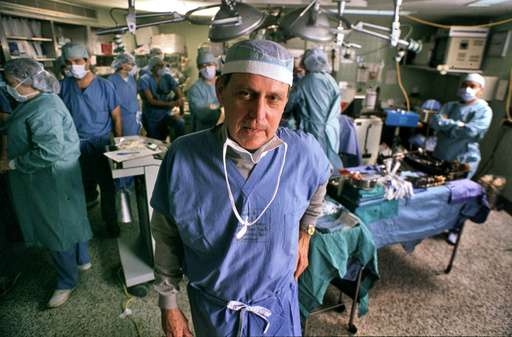Liver transplant surgical pioneer Dr. Thomas Starzl dies

Dr. Thomas Starzl, the pioneer of liver transplantation and the driving force behind the world's first baboon-to-human liver transplants and research on anti-rejection drugs, has died. He was 90.
The University of Pittsburgh, speaking on behalf of Starzl's family, said the renowned doctor died Saturday at his home in Pittsburgh.
Starzl performed the world's first liver transplant in 1963 and the world's first successful liver transplant in 1967, and pioneered kidney transplantation from cadavers. He later perfected the process by using identical twins and, eventually, other blood relatives as donors.
Since Starzl's first successful liver transplant, thousands of lives have been saved by similar operations.
Starzl joined the University of Pittsburgh School of Medicine in 1981 as professor of surgery, where his studies on the anti-rejection drug cyclosporin transformed transplantation from an experimental procedure into one that gave patients a hope they could survive an otherwise fatal organ failure.
It was Starzl's development of cyclosporin in combination with steroids that offered a solution to organ rejection.
Until 1991, Starzl served as chief of transplant services at UPMC, then was named director of the University of Pittsburgh Transplantation Institute, where he continued research on a process he called chimerism, based on a 1992 paper he wrote on the controversial theory that new organs and old bodies "learn" to co-exist without immunosupression drugs.
The institute was renamed in Starzl's honor in 1996, and he continued as its director.
In his 1992 autobiography, "The Puzzle People: Memoirs of a Transplant Surgeon," Starzl said he actually hated performing surgery and was sickened with fear each time he prepared for an operation.
"I was striving for liberation my whole life," he said in an interview.
Starzl's career-long interest in research rather than private practice began with a liver operation he assisted on while a resident at Johns Hopkins Hospital in Baltimore. After the surgery to redirect blood flow around the liver, he noticed the patient's sugar diabetes also had improved.
Thinking he had found the cause of diabetes to be in the liver rather than the pancreas, he designed experiments in 1956 with dogs to prove his discovery. He was wrong, but had started on the path that would lead to the first human liver transplants at the University of Colorado in Denver seven years later.
In September 1990, at age 65, Starzl put away his scalpel for good, soon after the death of a famous young patient: a 14-year-old girl from White Settlement, Texas, named Stormie Jones. Starzl also underwent a heart bypass operation in 1990 and suffered lingering vision problems from a laser accident five years earlier.
Stormie lived six years after a combination heart-liver transplant at age 8 but needed a second liver in 1990 and died within nine months. Her death affected Starzl greatly.
"It is true that transplant surgeons saved patients, but the patients rescued us in turn and gave meaning to what we did, or tried to," he once wrote.
Starzl was born March 11, 1926, in LeMars, Iowa. His mother was a nurse and his father was a science fiction writer and the publisher of the local newspaper. Starzl's uncle, the late Frank Starzel, was general manager of The Associated Press from 1948 to 1962.
© 2017 The Associated Press. All rights reserved.















